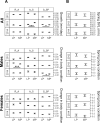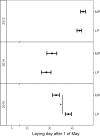Age-dependent effects of moderate differences in environmental predictability forecasted by climate change, experimental evidence from a short-lived lizard (Zootoca vivipara)
- PMID: 31664098
- PMCID: PMC6820789
- DOI: 10.1038/s41598-019-51955-7
Age-dependent effects of moderate differences in environmental predictability forecasted by climate change, experimental evidence from a short-lived lizard (Zootoca vivipara)
Abstract
Whether and how differences in environmental predictability affect life-history traits is controversial and may depend on mean environmental conditions. Solid evidence for effects of environmental predictability are lacking and thus, the consequences of the currently observed and forecasted climate-change induced reduction of precipitation predictability are largely unknown. Here we experimentally tested whether and how changes in the predictability of precipitation affect growth, reproduction, and survival of common lizard Zootoca vivipara. Precipitation predictability affected all three age classes. While adults were able to compensate the treatment effects, yearlings and juvenile females were not able to compensate negative effects of less predictable precipitation on growth and body condition, respectively. Differences among the age-classes' response reflect differences (among age-classes) in the sensitivity to environmental predictability. Moreover, effects of environmental predictability depended on mean environmental conditions. This indicates that integrating differences in environmental sensitivity, and changes in averages and the predictability of climatic variables will be key to understand whether species are able to cope with the current climatic change.
Conflict of interest statement
The authors declare no competing interests.
Figures



Similar articles
-
Decreased Precipitation Predictability Negatively Affects Population Growth through Differences in Adult Survival.Am Nat. 2020 Jan;195(1):43-55. doi: 10.1086/706183. Epub 2019 Nov 15. Am Nat. 2020. PMID: 31868534
-
Climate Effects on Growth, Body Condition, and Survival Depend on the Genetic Characteristics of the Population.Am Nat. 2017 Nov;190(5):649-662. doi: 10.1086/693780. Epub 2017 Aug 29. Am Nat. 2017. PMID: 29053364
-
Connectivity among thermal habitats buffers the effects of warm climate on life-history traits and population dynamics.J Anim Ecol. 2022 Nov;91(11):2301-2313. doi: 10.1111/1365-2656.13814. Epub 2022 Oct 3. J Anim Ecol. 2022. PMID: 36131637 Free PMC article.
-
Chronic elevation of glucorticoids late in life generates long lasting changes in physiological state without a life history switch.Gen Comp Endocrinol. 2020 Jan 1;285:113288. doi: 10.1016/j.ygcen.2019.113288. Epub 2019 Sep 23. Gen Comp Endocrinol. 2020. PMID: 31557468 Review.
-
The Potential for Rapid Evolution under Anthropogenic Climate Change.Curr Biol. 2019 Oct 7;29(19):R996-R1007. doi: 10.1016/j.cub.2019.08.028. Curr Biol. 2019. PMID: 31593684 Review.
Cited by
-
Climatic niche differences among Zootoca vivipara clades with different parity modes: implications for the evolution and maintenance of viviparity.Front Zool. 2021 Jun 29;18(1):32. doi: 10.1186/s12983-021-00403-2. Front Zool. 2021. PMID: 34183024 Free PMC article.
-
Global changes explain the long-term demographic trend of the Eurasian common lizard (Squamata: Lacertidae).Curr Zool. 2021 Jun 28;68(2):221-228. doi: 10.1093/cz/zoab051. eCollection 2022 Apr. Curr Zool. 2021. PMID: 35355947 Free PMC article.
References
-
- Bjørnstad ON, Hansen TF. Individual Variation and Population Dynamics. Oikos. 1994;69:167–171. doi: 10.2307/3545298. - DOI
Publication types
MeSH terms
LinkOut - more resources
Full Text Sources
Medical

